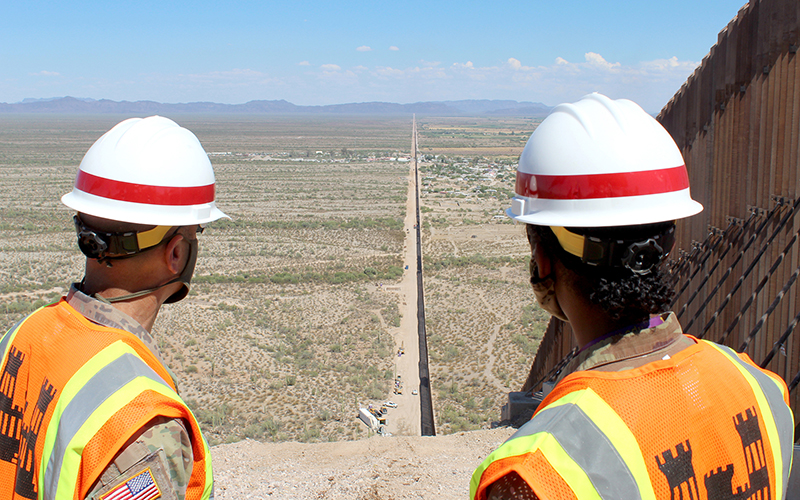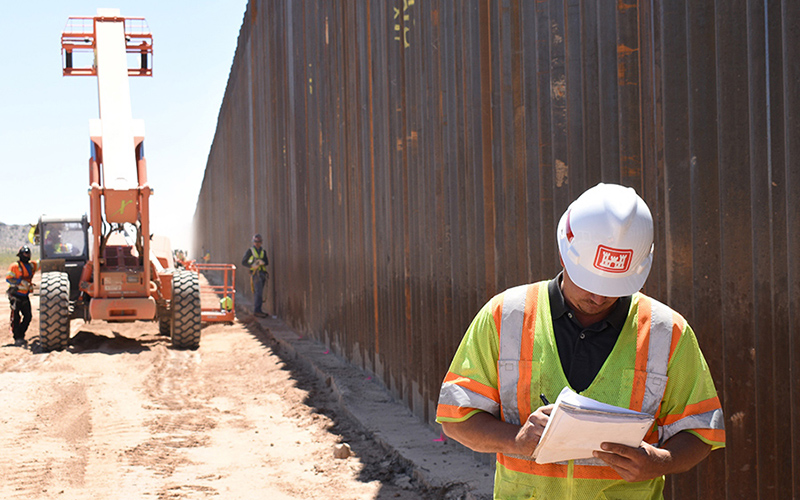WASHINGTON – President Donald Trump was in Yuma Tuesday for the second time in as many months to inspect construction of the border wall that he said has “closed up the border,” reducing the flow of drugs and migrants.
The visit came the same day that delegates to the Democratic National Convention were expected to formally nominate Vice President Joe Biden to challenge Trump this fall. Democrats quickly derided the president’s Yuma stop as little more than an “inaccurate and desperate” campaign stunt.
Democrats at the convention this week also adopted a campaign platform that pledges to undo much of the last four years of the Trump administration’s immigration policies. The platform’s immigration plank calls for more protection for DACA recipients, removal of some travel bans, expansion of asylum programs – and an end to border wall construction.
But Trump doubled down Tuesday, saying contractors could have 300 miles of border wall completed within the next week or two.
“Those are anti-climb plates at the top,” Trump said as he pointed to the top of the wall. “You see these guys climbing up with drugs on their back. They say, ‘Let’s take a pass on that.'”
But Santa Cruz County Sheriff Tony Estrada, in a conference call sponsored by Arizona Democrats before Trump’s visit, said a border wall is not a “silver bullet” for stopping drug trafficking, as most drugs come through ports of entry.
“We’re throwing money at something that’s not going to solve the problem,” Estrada said.
“When you look at the drug problem that we have, and then you look at the immigration issue, the immigration issue pales in comparison to the drug problem we have,” Estrada said.
Estrada pointed to early administration attempts to fortify the border, which included military troops stringing miles of concertina wire on the border. That treats immigrants worse than livestock are treated, he said.
“I think that that is about the cruelest thing any administration anywhere can do,” Estrada said. “To put razor wire strands to keep people from coming in is just cruel and inhumane.”
But Lora Ries defended efforts to toughen the border. The former acting chief of staff of the Department of Homeland Security said the border wall is vital to the work of Customs and Border Protection agents.
“In addition to personnel and technology infrastructure … the wall systems, the roads, the lights, etc., they provide CBP with more time to do their job,” Ries said. “They stop drugs from coming over.”
Apprehensions of migrants at the Southwest border have increased every month since April, according to the most recent data from CBP, which saw apprehensions grow from 17,086 immigrants in April to 40,746 in July.
But while those numbers were up this year, they were down sharply from last summer, when apprehensions topped 100,000 in every month from March to June, peaking at 144,116 in May.
While the parties fight over the best path forward on immigration, experts say there is likely to be little long-term reform – regardless of who sits in the White House – until Congress acts.
But whoever sits in the Oval Office is January is largely unimportant in addressing the largest issues facing the immigrant community.
“I think it’s unfortunate that presidents and Congresses of both parties have been unable to pass any reform,” said Ilya Shapiro, director of the Robert A. Levy Center for Constitutional Studies at the Cato Institute.
He said the last piece of major legislation on immigration came in 1996, under President Bill Clinton.
“We’re coming up on 25 years, so it’s a frustrating area policy that Congress has granted broad discretion to the president,” Shapiro said. “But whatever the president does in any direction, there are lawsuits.”
But that doesn’t mean the next president will be completely handcuffed. Congressionally approved border funding would be difficult to reverse, but discretionary spending, like that allocated after Trump declared a border emergency, could be reversed.
Joseph Garcia, executive director of Chicanos Por La Causa, agreed that Congress needs to step up.
“The crux of the problem is that immigration has been dealt with on every level except where it is supposed to be, and that is through Congress,” Garcia said. “It’s a federal issue.”
Congress should care because voters care, Garcia said.
“For many people, immigration issues are a very emotional but ideological response, it’s mostly political rhetoric,” he said. “But for the Latino community, immigration is a very real scenario when a loved one or a friend, or a neighbor, or a co-worker could be adversely affected and deported.”
But neither Garcia nor Shapiro is optimistic, particularly in an election year when Republicans can appeal to voters’ fear of immigrants and Democrats look to tap into the largest minority demographic through appeals of compassion.
“Until there’s some sort of legislation, we’re going to be having these asymmetric battles over different aspects of immigration policy,” Shapiro said.
But, as Garcia noted, “Whenever you bring immigration into the discussion. It sucks, all the oxygen out of the room.”



